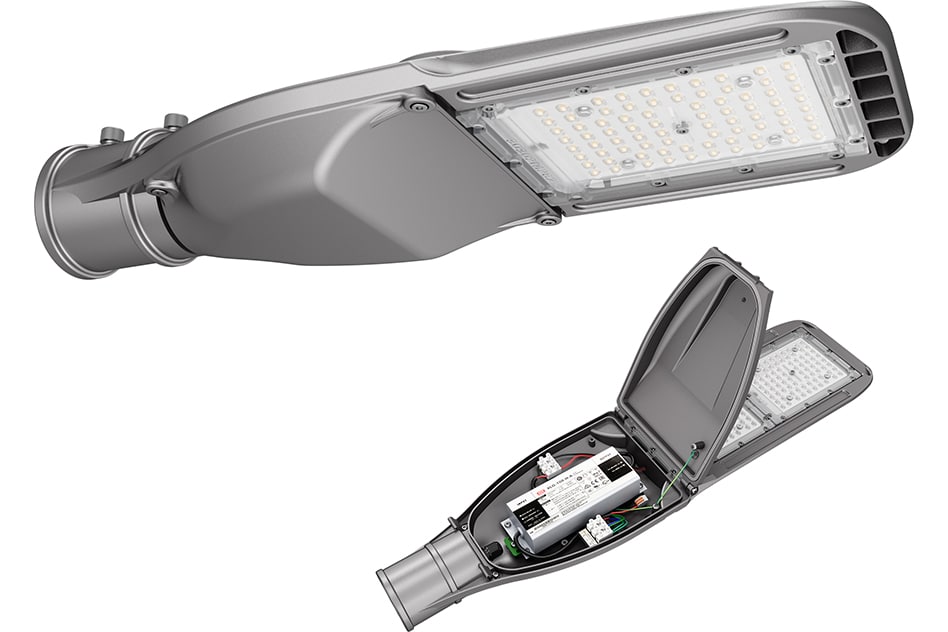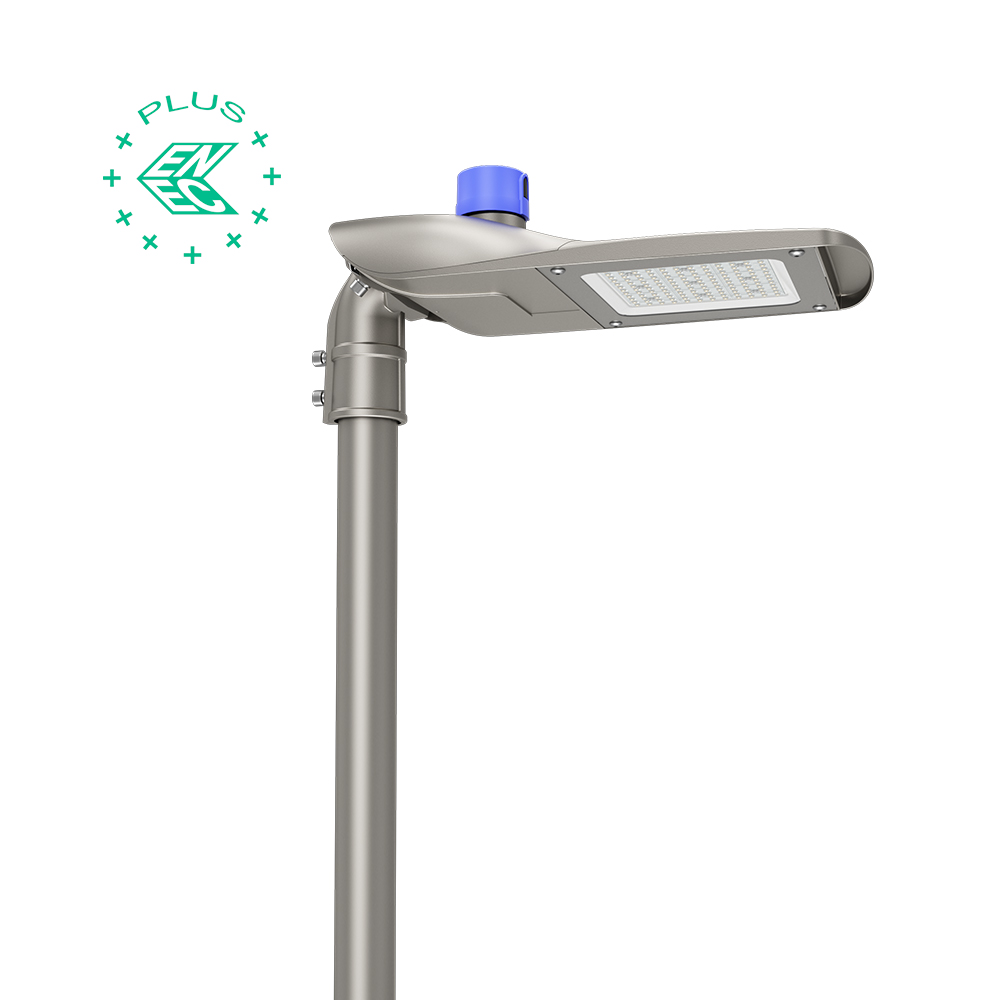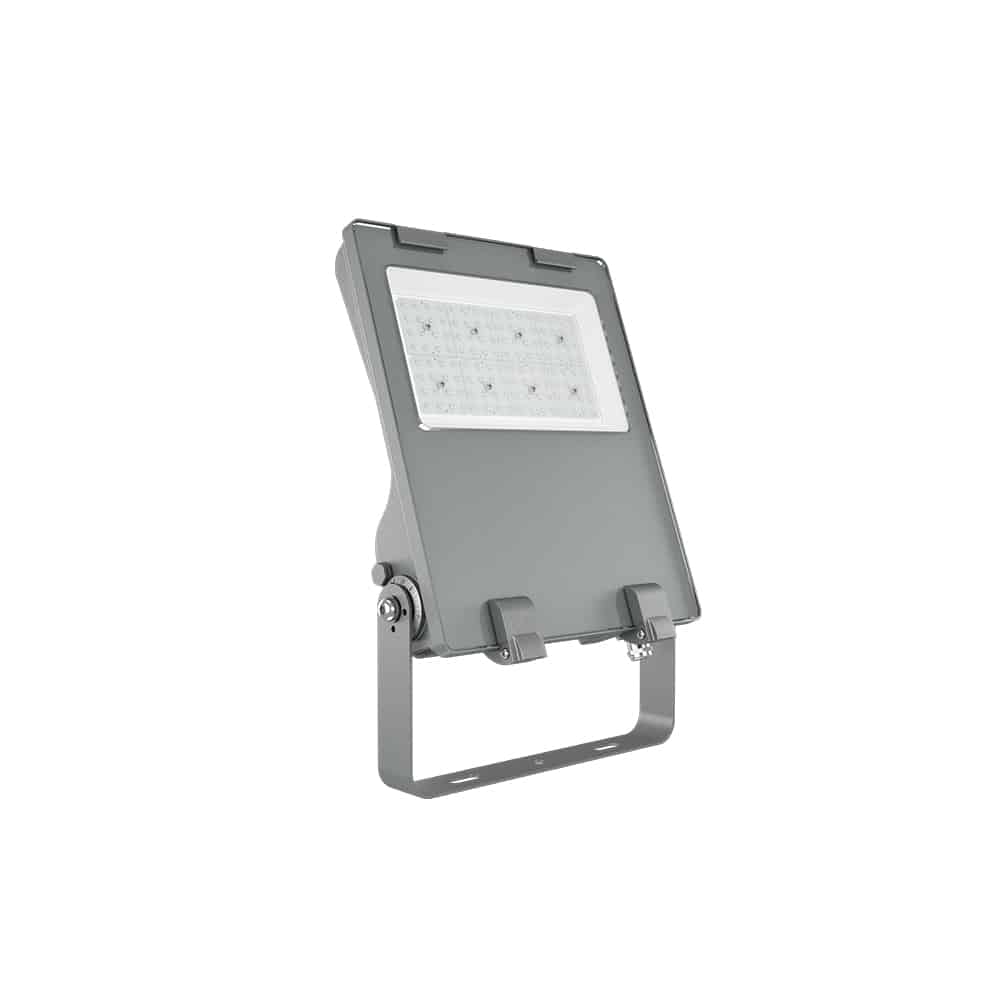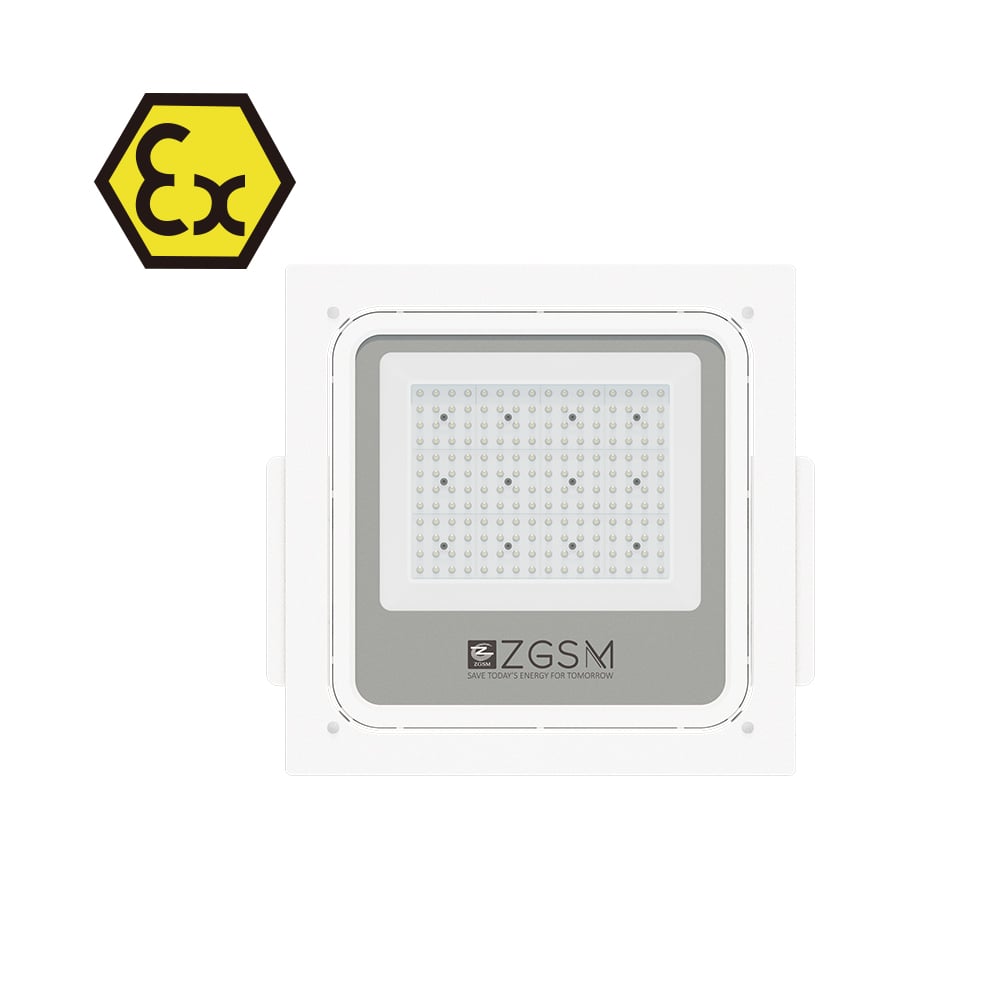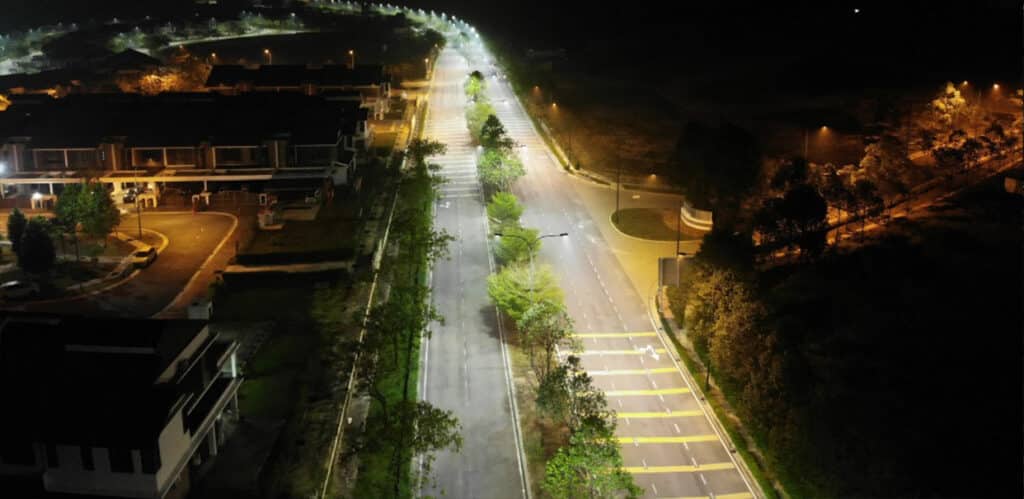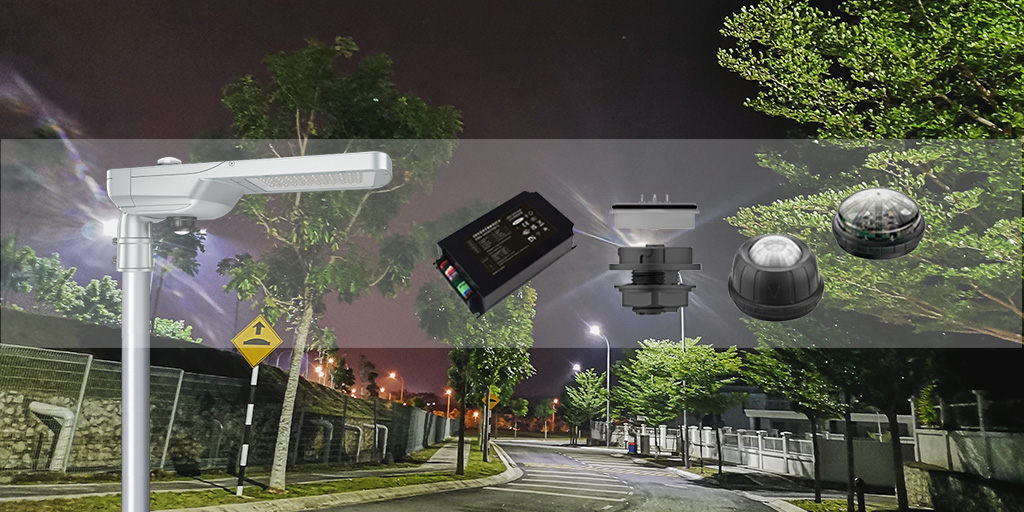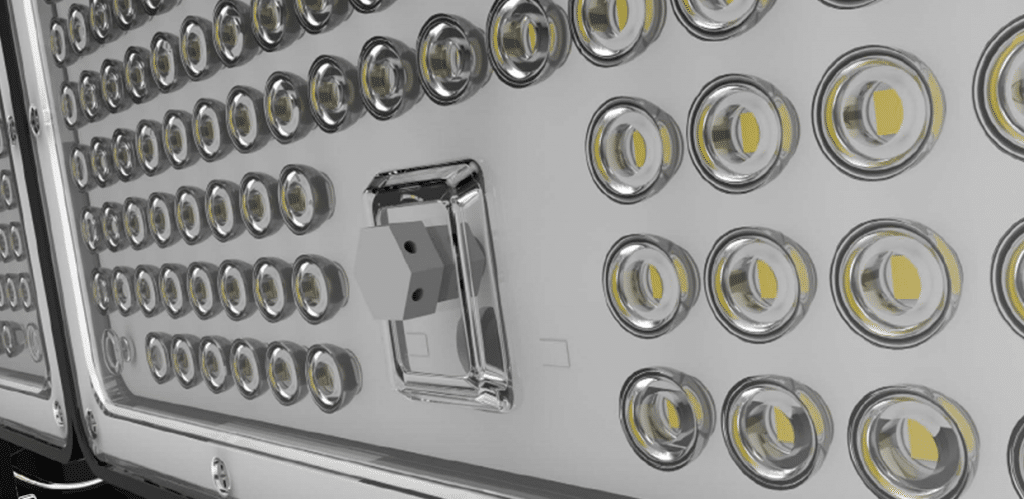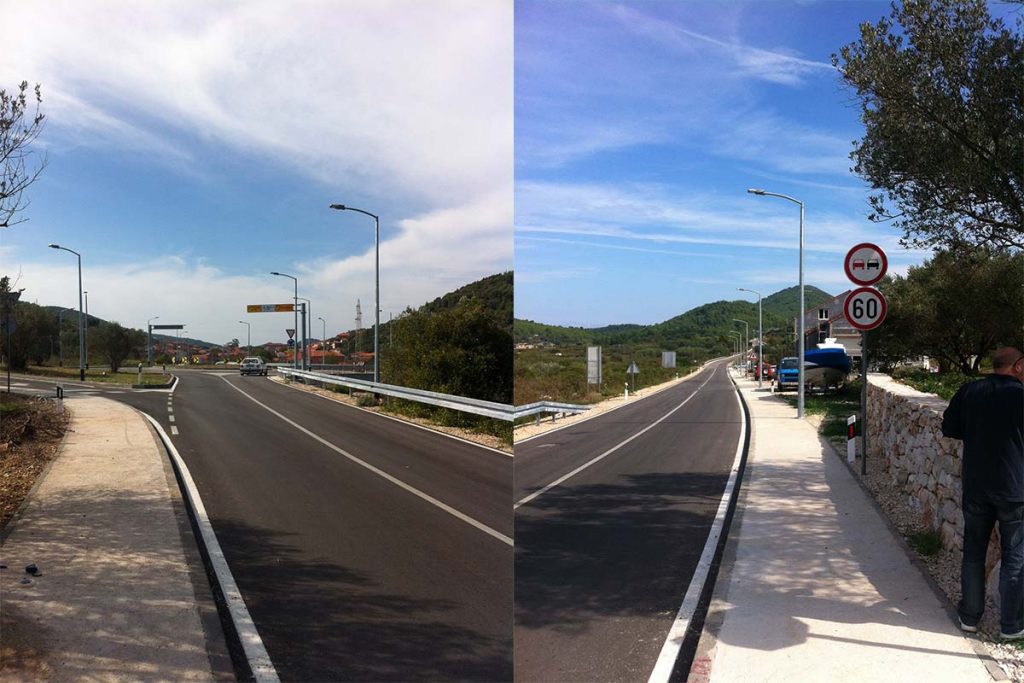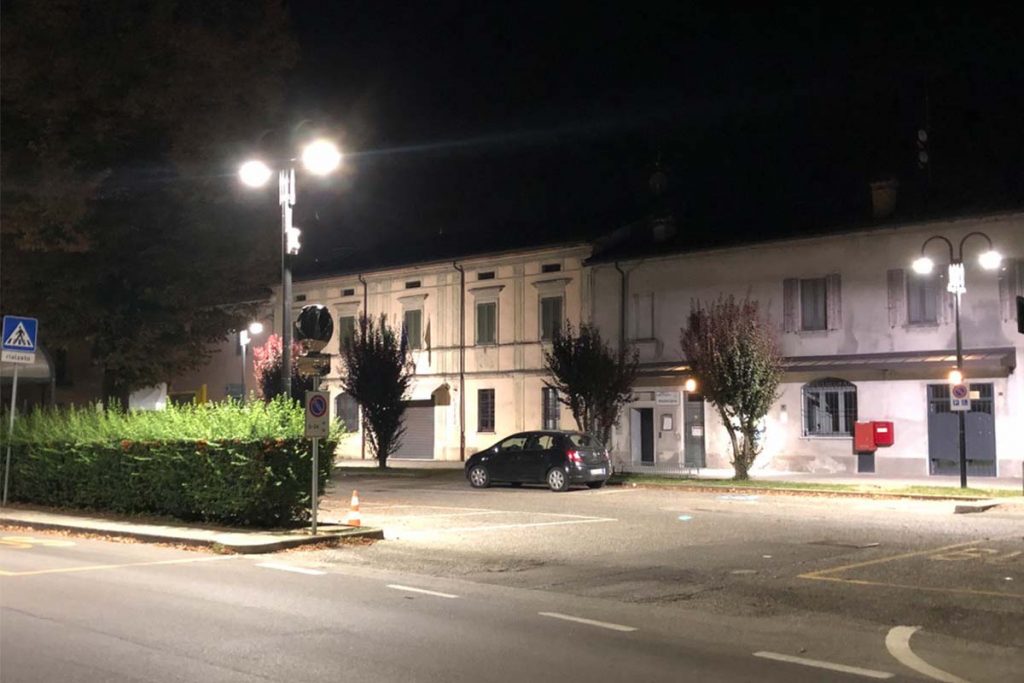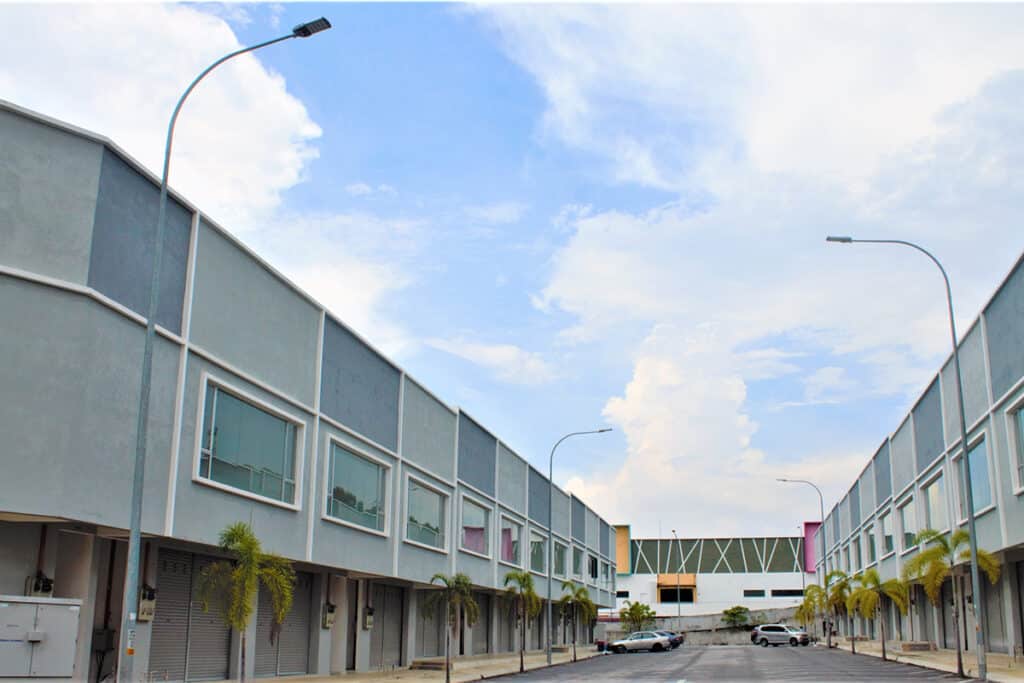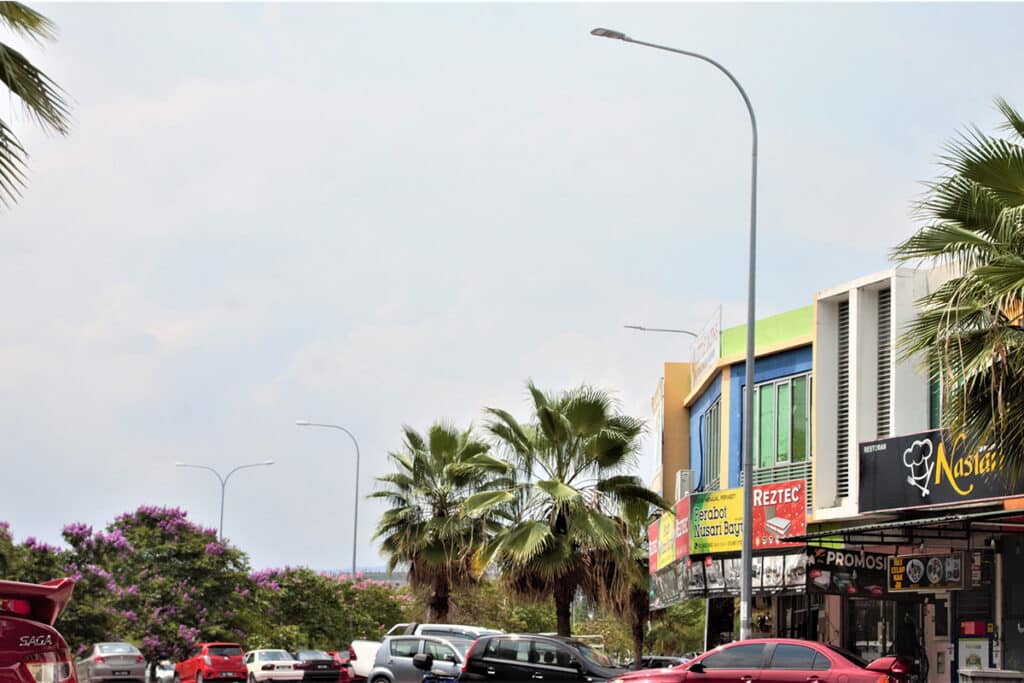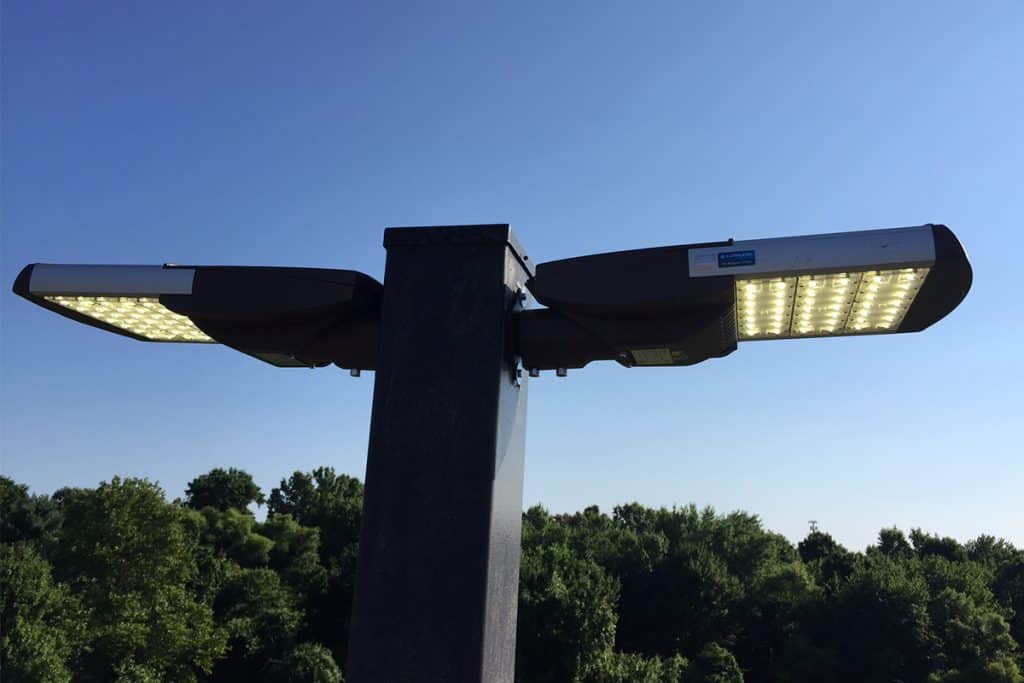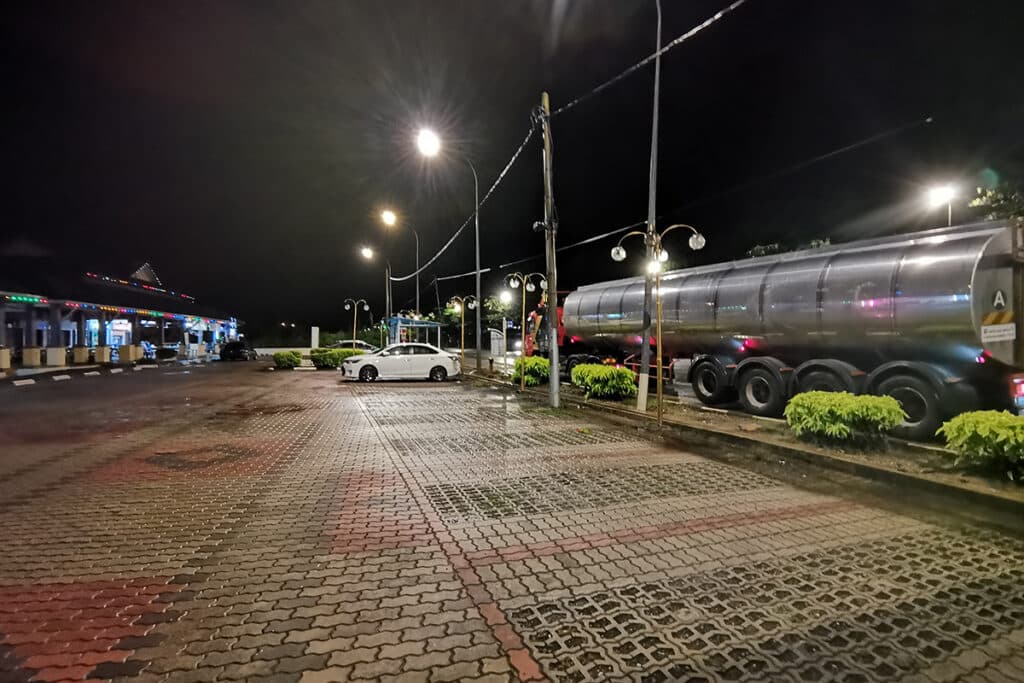LED street light with NTC thermistor and over temperature protection
LED street light with NTC thermistor and over temperature protection
Introduction
LED street lights have been proven in a wide range of applications in recent years, proving their ability to provide efficient and long-lasting lighting in roads, parking lots, squares and other outdoor areas. However, a reasonable luminaire design is crucial. Some unreasonable designs, such as too small heat sink, too large power of LEDs and too close distance between the power supply and the heat sink, may cause the LED street light to fail to work properly. This is because both the LEDs and the power supply need to work at an appropriate temperature, and excessive temperature may cause aging or even damage to electronic components. However, street lights with over-temperature protection can safely operate in high-temperature environments. At normal temperature, the lamp will work normally. However, when the temperature is too high (such as extreme weather, abnormal heat accumulation, abnormal LED drive output, etc.), the over-temperature protection will play a role. LED street light ( View the case study of LED street light heads. ) with NTC thermistors will reduce or cut off the power output to ensure that the lamp can continue to work normally. This article aims to explain NTC-related knowledge, the application of NTC in street lamps and how street light with NTC thermistors can realize the function of over-temperature protection.

Basic Principles of NTC thermistor
Negative temperature coefficient thermistor, also known as NTC thermistor, is a kind of sensor resistance whose resistance value decreases with the increase of temperature. Widely used in various electronic components, such as temperature sensors, resettable fuses and self-adjusting heaters, etc. For example, we often see that heaters and electric kettles will cut off the output when the temperature reaches the specified requirements, which has the function of NTC thermistor. This property of NTCs makes NTC resistors useful for sensing and measuring temperature changes in many applications. In order to achieve over-temperature protection, LED street lights ( Please review case studies of LED light street. ) usually use NTC (negative temperature coefficient) thermistors. It is placed at key locations inside the luminaire to monitor temperature changes. When the temperature rises beyond the safe range, the NTC thermistor will trigger the protection mechanism and reduce the power output, thus preventing the lamp from being damaged due to overheating. Below is the table refers to the relationship between temperature and resistance.
| Temperature (deg.C) | R-low (k ohm) | R-center (k ohm) | R-high (k ohm) |
| -10 | 39.8007 | 42.5062 | 45.282 |
| 0 | 25.6001 | 27.2186 | 28.8672 |
| 10 | 16.9301 | 17.9255 | 18.932 |
| 20 | 11.4548 | 12.0805 | 12.7085 |
| 25 | 9.5000 | 10.0000 | 10.5000 |
| 30 | 7.8842 | 8.3145 | 8.7464 |
| 35 | 6.5765 | 6.9479 | 7.3219 |
| 40 | 5.5122 | 5.8336 | 6.1584 |
| 45 | 4.638 | 4.9169 | 5.1995 |
| 50 | 3.9183 | 4.1609 | 4.4074 |
| 55 | 3.3235 | 3.535 | 3.7505 |
| 60 | 2.8294 | 3.0143 | 3.2032 |
| 65 | 2.4238 | 2.5861 | 2.7524 |
| 70 | 2.0846 | 2.2275 | 2.3743 |
| 75 | 1.7984 | 1.9245 | 2.0543 |
Why go with NTC thermistor function?
In some areas with hot climates, the working environment of street lamps and other LED lamps is relatively high. If it exceeds its suitable working temperature, the internal components of LED lamps, such as power supply, LED chips and other components, will heat up significantly. When it exceeds its ability to withstand, the lamp will stop working. In severe cases, the life of components will be shortened or even faults, and even safety hazards. When the street lamp is equipped with the function of over-temperature protection (NTC thermistor function), it can reduce the impact of high temperature on the lamp. Therefore, the summary of the application advantages of NTC function in LED lamps mainly includes the following points:
Extend service life: Excessive temperature will accelerate the aging of electronic components in LED lamps. By implementing over temperature protection(OTP), the temperature of each component of LED lamps can be kept within an ideal range, which is very important for prolonging the service life of street lighting. Advantageously, this also further reduces the maintenance and replacement costs of LED lamps.
Improve the light efficiency of lamps: Relevant studies have shown that when LED chips operate at high temperatures, their efficiency will be significantly reduced. Referring to the LM82 report, for the same LED street lamp at Ta25°C, 50°C and 65°C, the luminous efficacy of the LED lamps is reduced by more than 10%. The over-temperature protection function is added to the LED lamps to ensure that the lamps are maintained at the optimum working temperature, which is good for maintaining high luminous efficacy of the lamps. At the same time, the low temperature is also very beneficial to the lumen maintenance of the lamps as per TM21 report.
Increased Safety: Overheated components inside the luminaire may pose a safety risk such as fire, electric shock or other hazardous conditions. The over temperature protection function can prevent the lamp from overheating, thereby reducing this risk from the source and preventing the occurrence of fire, etc.
Operating Principles of LED street Light with NTC thermistor?
The basic principle of NTC thermistor (Negative Temperature Coefficient) on street lamps is to use the characteristics of NTC thermistors to monitor the temperature of various parts of street lamps, including LED chips and power supplies. According to the characteristics of the NTC thermistor (its resistance value decreases with the increase of temperature), the LED driver can detect the change of resistance, and deduce the temperature of each part of the lamp through the resistance. If the resistance is less than the set value, the LED The driver will lower the current or even cut off the output, so as to avoid the accumulation of heat and affect the normal operation of the lamp. The following is the basic structural design of street light with NTC thermistor:
NTC installation location: NTC thermistors are usually placed near LED chips of street lamp, power supply and heat dissipation structures. By detecting the temperature changes in these key positions, it can be judged whether the lamps are working abnormally.
Resistance measurement: The street light control system (usually LED driver) will measure the resistance value of the NTC thermistor periodically or continuously, and then judge the temperature of each component, so the selection of the resistance value of the NTC thermistor is very important. Take the EBS power supply as an example, 3014Ω and 1924Ω, which are the two default resistance values in the NTC function of the power supply. 60 ℃ corresponds to 3014 ohms, the lamp starts to reduce the output), and continues until 1924 ohms (reduced to 60%). When the NTC is connected to a circuit, the measurement result will reflect the temperature inside the lamp, so the resistance value of the varistor, the temperature and the selection of the LED driver must match to ensure the normal operation of the NTC function.
Power supply function: The LED driver must ensure that the power supply has the function of detecting the size of the resistor. Inventronics calls this function thermal sensing and protection for LED Module. The power supply NTC+ and NTC- are respectively connected to the resistor through wires to detect the temperature of the aluminum substrate (lamp bead). The picture below is a photo of ZGSM street light equipped with NTC thermistor function. And the typical wiring diagram of a street lamp with NTC thermistor function is shown below.

LED solution’s over temperature protection – two solutions
The over-temperature protection function of ZGSM includes two types, one is the over temperature protection of the power supply, and the other is the over temperature protection of LED chips. ZGSM believes that the power supply and LED chips are the two most important parts of LED lamps, ensuring their normal transportation, the lamps can work efficiently and stably for a long time.
LED driver with NTC thermistor for over temperature protection
Over temperature protection of the power supply, through the built-in varistor of the power supply, the LED driver can detect the change of resistance by itself to determine whether the power supply is overheated. When the temperature of the power supply is too high and the resistance decreases, the LED driver can detect this change and reduce the power appropriately to avoid overheating of the power supply.
LEDs with NTC thermistor for over temperature protection
For the over temperature protection of the LEDs, we install the NTC thermistor on the Ts point of LEDs or the PCB), and complete the wiring with the LED driver. Inventronics call this Thermal sensing and protection for LED module. By detecting the resistance change of the NTC thermistor installed on the LEDs/PCB, it is determined whether the LED chip is overheated. When the temperature of the LEDs chips/PCB is too high and the resistance decreases, the LED driver can detect this change and reduce the power appropriately to avoid overheating of the LED chips/PCB.
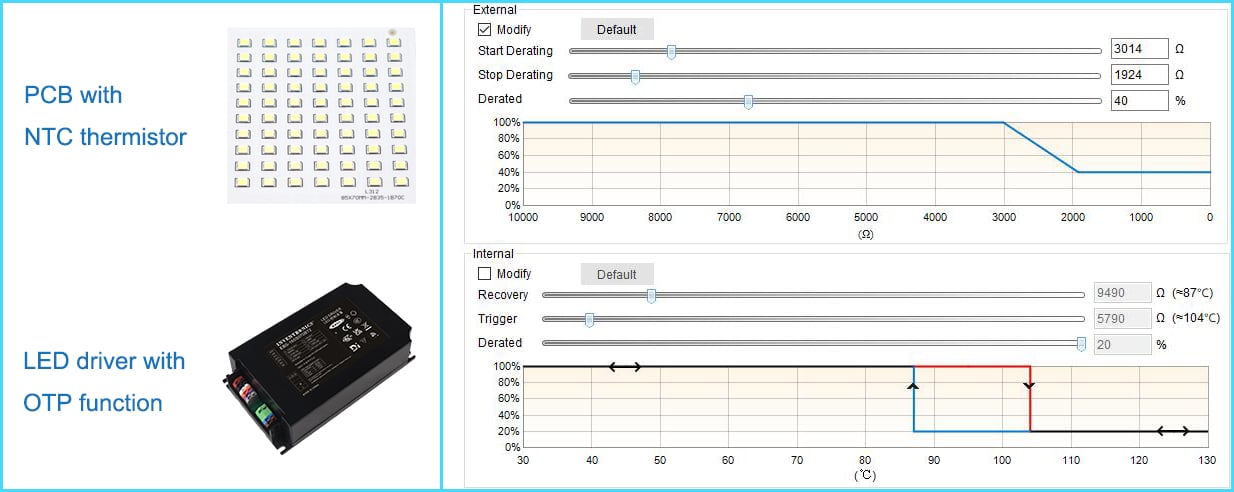
ZGSM LED street light with NTC thermistor solution
All ZGSM LED lamps can be equipped with NTC thermistor for over temperature protection. The following are our products, including LED street lights, flood lights, stadium lights, gas station lights and factory lights, etc. Among them, the over temperature protection function of the LED power supply is equipped by default. If you need the LED chips to also be equipped with this function, please contact ZGSM for solutions and quotations. Below the ZGSM LED street light with NTC thermistors.
Summary
This article mainly explains what is NTC, the application of NTC in street lamp over temperature protection, the significance of street lamp with over temperature protection, and the wiring and working principle of street light with NTC thermistor. Through this article we know that street lamps can prevent damage to lamps due to excessive temperature in two aspects, namely, damage to LEDs and power supply. By introducing NTC resistors, LED lamps can cut off and reduce the output of LED power supply in time to prevent heat from accumulating in the lamps, thereby reducing the impact of high temperature on lamps. ZGSM is happy to provide such solutions for customers, but generally our LED lamps are designed reasonably, which ensures that the Ts temperature of the LED chips and the Tc point temperature of the power supply are both within the working temperature range of LEDs and LED driver. ZGSM is happy to provide relevant certificates or reports, contact us for more information about LED street light with NTC thermistor/OTP ( View more about the case study of LED street light ).
Rated Products
Related Blogs
Related Cases
People also ask
Author introduction

Hello Customers,
My name is Taylor Gong, I’m the product manager of ZGSM Tech. I have been in the LED lights industry for more than 13 years. Good at lighting design, street light system configuration, and bidding technology support. Feel free to contact us. I’m happy to provide you with the best service and products.
Email: [email protected] | WhatsApp: +8615068758483




